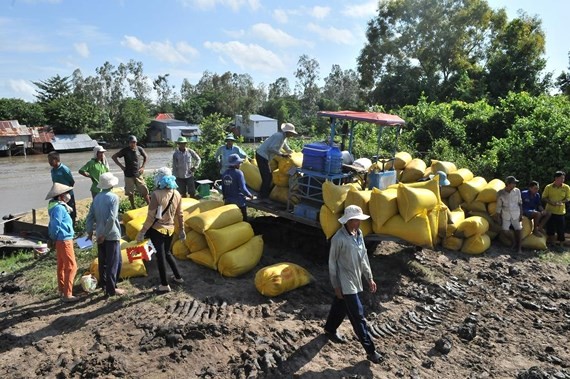
In order to enjoy a bumper crop, the ministry ordered provinces to choose suitable time to start cultivation of rice so that it will not affect the autumn-winter rice crop this year, apply measures to avoid drought and salinity and comply with the principles to grow rice in accord with water supply and brown plant-hopper migration forecasts.
The mass cultivation is expected to be from April to June this year. Of the rice growing structure, high quality rice variety accounts for 50-60 percent, fragrant rice takes 20-25 percent, glutinous rice variety makes up 5-7 percent, medium-quality rice variety maintains a ratio of 15 percent and the rest is other rice varieties.
Deputy minister of MARD Le Quoc Doanh asked Mekong Delta provinces to apply technical solutions to reduce cost price, improve quality and ensure food safety as well as calculate and forecast production and types of rice for smooth consumption. The ministry will collaborate with provinces to make plans, deploy and closely monitor the cultivation of rice and have solutions to deal with difficulties and abnormal weather conditions to secure summer-autumn rice crop production.
On March 21, the MARD held a meeting to summarize the winter-spring rice crop production and deploy plans for production of the summer-autumn rice crop in Southern provinces.
According to the Department of Cultivation, total rice growing area of the winter-spring rice crop in Southern provinces was more than 1.68 million hectares, up 30,109 hectares. Rice productivity was estimated at 68.35 quintals per hectare, up 0.01 quintals per hectare. Rice yield was estimated to exceed 11.5 million tons, up 208,000 tons over the same period last year. of which, provinces in the Mekong Delta grew rice on an area of 1.6 million hectares with productivity at 68.87 quintals per hectare, a decrease of 0.02 quintals per hectare, and estimated production of 11.05 million tons.
Most Mekong Delta provinces grew rice 7-14 days earlier than last year. Rice grown in November and December last year gave lower yield than expected due to prolonged hot weather. In addition, many provinces increased the proportion of fragrant and high quality rice varieties which produce lower yield than other varieties, causing average rice productivity to decrease but the prices of these rice varieties were much higher, hereby improving economic efficiency.
In related news, the People’s Committee of Dong Thap Province announced that the province has disbursed more than VND2.1 billion to carry out measures to save citrus groves in the province as several citrus groves in Lai Vung District were infected with diseases and died, causing huge losses to farmers.
Accordingly, the provincial committee ordered the Department of Agriculture and Rural Development to summarize the result of a research by the Southern Fruit Research Institute and Can Tho University to draw out treatments for infected citrus groves, ways to dispose dead trees and warnings for newly-grown and trees that have not been infected. The department was also asked to build technology-applied citrus growing models for safe, effective and sustainable production then transfer to farmers. In addition, it will keep finding out the reasons and factors that made citrus trees die then present procedure to control the diseases effectively.
According to the department, there is an area of 8,056 hectares of citrus trees in the province, of which, Lai Vung District accounts for 65 percent of the total area. In the past three years, diseases on citrus trees started to break out, increasing the area of dead citrus trees to more than 2,000 hectares.
























